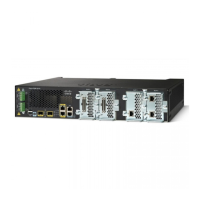16-13
Catalyst 3550 Multilayer Switch Software Configuration Guide
78-11194-09
Chapter 16 Configuring STP
Configuring Spanning-Tree Features
The switch supports PVST+, rapid PVST+, and MSTP, but only one version can be active at any time.
(For example, all VLANs run PVST+, all VLANs run rapid PVST+, or all VLANs run MSTP.) For
information about the different spanning-tree modes and how they interoperate, see the “Spanning-Tree
Interoperability and Backward Compatibility” section on page 16-10.
The UplinkFast, BackboneFast, and cross-stack UplinkFast features are not supported with rapid PVST+
or MSTP.
Changing the Spanning-Tree Mode
The switch supports three spanning-tree modes: PVST+, rapid PVST+, or MSTP. By default, the switch
runs the PVST+ protocol.
Beginning in privileged EXEC mode, follow these steps to change the spanning-tree mode. If you want
to enable a mode that is different from the default mode, this procedure is required.
Command Purpose
Step 1
configure terminal Enter global configuration mode.
Step 2
spanning-tree mode {pvst | mst |
rapid-pvst}
Configure a spanning-tree mode.
• Select pvst to enable PVST+ (the default setting).
• Select mst to enable MSTP (and RSTP). For more configuration
steps, see Chapter 17, “Configuring MSTP.”
• Select rapid-pvst to enable rapid PVST+.
Step 3
interface interface-id (Recommended for rapid-PVST+ mode only) Enter interface
configuration mode, and specify an interface to configure. Valid
interfaces include physical ports, VLANs, and port channels. The
VLAN ID range is 1 to 4094. The port-channel range is 1 to 64.
Step 4
spanning-tree link-type point-to-point (Recommended for rapid-PVST+ mode only) Specify that the link type
for this port is point-to-point.
If you connect this port (local port) to a remote port through a
point-to-point link and the local port becomes a designated port, the
switch negotiates with the remote port and rapidly transitions the local
port to the forwarding state.
Step 5
end Return to privileged EXEC mode.
Step 6
clear spanning-tree detected-protocols (Recommended for rapid-PVST+ mode only) If any port on the switch
is connected to a port on a legacy 802.1D switch, restart the protocol
migration process on the entire switch.
This step is optional if the designated switch determines that this switch
is running rapid PVST+.
Step 7
show spanning-tree summary
and
show spanning-tree interface
interface-id
Verify your entries.
Step 8
copy running-config startup-config (Optional) Save your entries in the configuration file.

